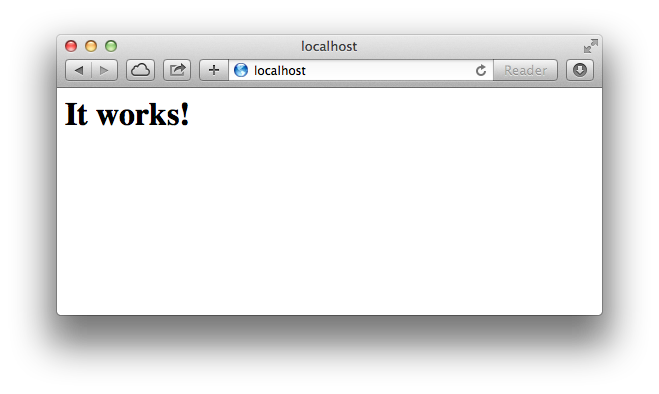Setup local web server with Apache and PHP on MacOS X Mavericks
Update 2014-11-25: I have created an updated article on how to setup Apache and PHP in OS X Yosemite.
This a quick writeup of how to get a local web development server up and running on your Mac. Everything you need is preinstalled, and just needs to be configured. Some familiarity with the Terminal is presumed (e.g. how to start it).
After this tutorial you will have a working local Apache server with PHP, and I will show you how to create sub sites for each of your web projects directly from Dropbox.
Apache
As I said everything you need should already be installed on your new Mavericks machine, so go ahead and and write the following in a Terminal window:
httpd -v
This will show you the installed version of Apache, which is Apache/2.2.24 on Mavericks. Start Apache with the following command:
sudo apachectl start
Now you can test that Apache is running by opening http://localhost in a browser. You should see the text “It works!”.

The document you are seeing is served from the system level web root, located in /Library/WebServer/Documents. We want to create a user level web root for our own projects, and we’ll do it all from the Terminal:
mkdir ~/Sites
Then we need to create a new user config for Apache (substitute your own user account short name):
sudo nano /etc/apache2/users/username.conf
Paste the following config into the Terminal editor:
<Directory "/Users/username/Sites/">
Options Indexes MultiViews FollowSymLinks
AllowOverride All
Order allow,deny
Allow from all
</Directory>Press CTRL+O and then CTRL+X to save and exit.
PHP
Now we want to enable PHP, so you can actually develop something. Mavericks comes with PHP 5.4.17, so now we need to turn it on:
sudo nano /etc/apache2/httpd.conf
Use CTRL+W to search within nano and search for “php”. Uncomment the first line you find (remove the #):
LoadModule php5_module libexec/apache2/libphp5.so
Press CTRL+O and then CTRL+X to save and exit. Restart Apache for the change to kick in:
sudo apachectl restart
To test that PHP is now working, create a PHP test file in your new user level web root (~/Sites) with the following command:
printf "<?php phpinfo(); ?>" > ~/Sites/phpinfo.php
Test it by opening http://localhost/~username/phpinfo.php in a browser.

Run sites from Dropbox
Now we actually want to develop and test some websites locally, and if you are like me, they are all located in Dropbox. It would be quite a pain to copy the project to ~/Sites every time we make a change, so why not just create a reference to it?
Let’s say you have a web project in ~/Dropbox/Projects/MyWebsite, let’s create a symbolic link to it in our ~/Sites folder:
ln -s ~/Dropbox/Projects/MyWebsite ~/Sites/MyWebsite
We are not quite there yet though. Due to some probably quite reasonable security restrictions, we have to grant Apache access to read and serve files from this Dropbox folder. With the following we grant access to the entire Projects folder, but you can be more/less restrictive:
chmod a+rx ~/Dropbox/Projects
To test your site open http://localhost/~username/MyWebsite in a browser.
Update 2014-04-16: You might run into some permission issues with Dropbox. To fix this you have to use chmod +x on every folder in the path from user root. So if you have linked folder ~/Dropbox/MySites/SiteA, you have to use chmod on both ~/Dropbox, ~/Dropbox/MySites and ~/Dropbox/MySites/SiteA. And remember to do a restart of Apache after each change before you test.
This was just a quick tutorial to get your local development server up and running. If you think anything could be done easier or better in some way, please drop me a comment.
If you want to use custom hostnames for testing, check out my other article on how to setup Apache with Virtual Hosts.